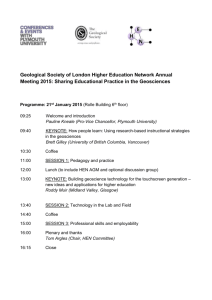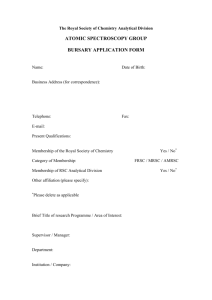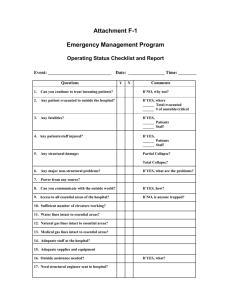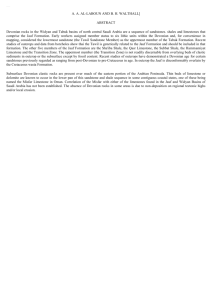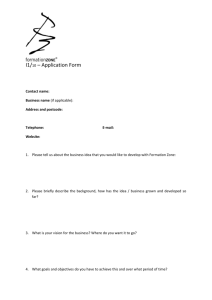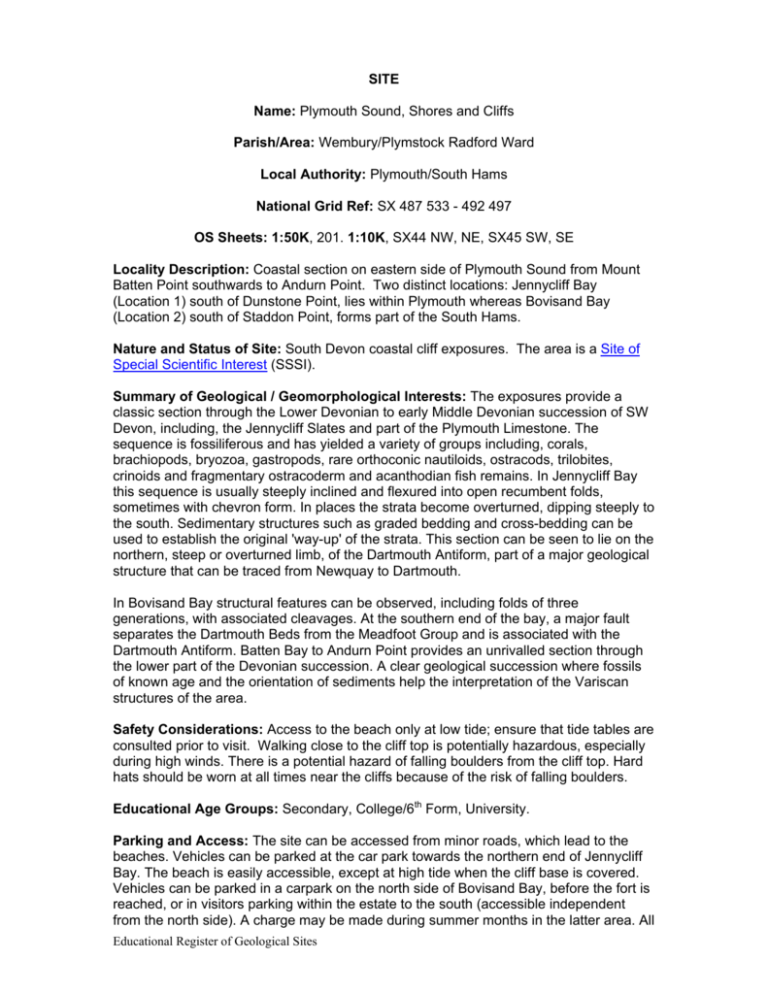
SITE
Name: Plymouth Sound, Shores and Cliffs
Parish/Area: Wembury/Plymstock Radford Ward
Local Authority: Plymouth/South Hams
National Grid Ref: SX 487 533 - 492 497
OS Sheets: 1:50K, 201. 1:10K, SX44 NW, NE, SX45 SW, SE
Locality Description: Coastal section on eastern side of Plymouth Sound from Mount
Batten Point southwards to Andurn Point. Two distinct locations: Jennycliff Bay
(Location 1) south of Dunstone Point, lies within Plymouth whereas Bovisand Bay
(Location 2) south of Staddon Point, forms part of the South Hams.
Nature and Status of Site: South Devon coastal cliff exposures. The area is a Site of
Special Scientific Interest (SSSI).
Summary of Geological / Geomorphological Interests: The exposures provide a
classic section through the Lower Devonian to early Middle Devonian succession of SW
Devon, including, the Jennycliff Slates and part of the Plymouth Limestone. The
sequence is fossiliferous and has yielded a variety of groups including, corals,
brachiopods, bryozoa, gastropods, rare orthoconic nautiloids, ostracods, trilobites,
crinoids and fragmentary ostracoderm and acanthodian fish remains. In Jennycliff Bay
this sequence is usually steeply inclined and flexured into open recumbent folds,
sometimes with chevron form. In places the strata become overturned, dipping steeply to
the south. Sedimentary structures such as graded bedding and cross-bedding can be
used to establish the original 'way-up' of the strata. This section can be seen to lie on the
northern, steep or overturned limb, of the Dartmouth Antiform, part of a major geological
structure that can be traced from Newquay to Dartmouth.
In Bovisand Bay structural features can be observed, including folds of three
generations, with associated cleavages. At the southern end of the bay, a major fault
separates the Dartmouth Beds from the Meadfoot Group and is associated with the
Dartmouth Antiform. Batten Bay to Andurn Point provides an unrivalled section through
the lower part of the Devonian succession. A clear geological succession where fossils
of known age and the orientation of sediments help the interpretation of the Variscan
structures of the area.
Safety Considerations: Access to the beach only at low tide; ensure that tide tables are
consulted prior to visit. Walking close to the cliff top is potentially hazardous, especially
during high winds. There is a potential hazard of falling boulders from the cliff top. Hard
hats should be worn at all times near the cliffs because of the risk of falling boulders.
Educational Age Groups: Secondary, College/6th Form, University.
Parking and Access: The site can be accessed from minor roads, which lead to the
beaches. Vehicles can be parked at the car park towards the northern end of Jennycliff
Bay. The beach is easily accessible, except at high tide when the cliff base is covered.
Vehicles can be parked in a carpark on the north side of Bovisand Bay, before the fort is
reached, or in visitors parking within the estate to the south (accessible independent
from the north side). A charge may be made during summer months in the latter area. All
Educational Register of Geological Sites
areas of the site are accessible, except at high tide when the cliff base is covered. The
South West Coast Path winds along the site so access on foot is possible. There is also
a regular bus service from Plymouth (Royal Parade) to Turnchapel. For timetable
details, visit www.traveline.org.uk.
References
CHANDLER, P. and McCALL, G.J.H. 1985. Stratigraphy and structure of the PlymouthPlymstock area: a preliminary review. Proc. Ussher Soc. 6, 253-257.
CHAPMAN, T.J. 1983. A guide to the structure of the Lower to Middle Devonian Staddon
Grits and Jennycliff Slates on the east side of Plymouth Sound, Devon. Proc. Ussher
Soc. 5: 460-464.
DINELEY, D. L. (1966). The Dartmouth Beds of Bigbury Bay, South Devon, Quat. Jour.
Geol. Soc., 122, 187-217
HARWOOD, G.M. 1976. The Staddon Grits – or Meadfoot Beds? Proc. Ussher Soc. 7,
212-216.
HENDRIKS, E.M.L. 1951. Geological succession and structure in western south
Devonshire. Trans. Roy. Geol. Soc. Cornwall, 18, 255-308.
HOBSON, D. M. (1976). The Structure of the Dartmouth Antiform. Proc. Ussher. Soc., 3,
320-32.
HOBSON, D. M. (1978). The Plymouth area. Geologist’s Association Guide No. 38.
LEVERIDGE, B.E., HOLDER, M.T., GOODE, A.J.J., SCRIVENER, R.C., JONES, N.S.
and MERRIMAN, R.J. 2002. Geology of the Plymouth and south-east Cornwall Area.
Memoir of the British Geological Survey, Sheet 348 (England and Wales), 143pp
ORME, A.R. 1960. The raised beaches and strandlines of South Devon. Field Studies 1:
109-130.
POUND, C.J. 1983. The sedimentology of the Lower-Middle Devonian Staddon Grits
and Jennycliff Slates on the east side of Plymouth Sound, Devon. Proc. Ussher. Soc., 5,
465-472.
SEAGO, R.D. and CHAPMAN, T.J. 1988. The confrontation of structural styles and the
evoluition of a foreland basin in central south-west England. Jl. Geol. Soc. Lond. 145,
789-900.
TAYLOR, P.W. 1951. The Plymouth Limestone: and the Devonian tetracorals of the
Plymouth Limestone. Trans. Roy. Geol. Soc. Cornwall, 18, 146-214.
USSHER, W.A.E. 1912. The geology of the country around Ivybridge and Modbury.
Memoirs of the Geological Survey, England and Wales . London, HMSO.
USSHER, W.A.E. and FLETT, J.H. 1907. The geology of the country around Plymouth
and Liskeard (Sheet 348). Memoirs of the Geological Survey, England and Wales,
156pp
Educational Register of Geological Sites
Detailed Geology: Jennycliff Bay exposes the younger Lower Devonian and Middle
Devonian rocks on the northern flank of the Dartmouth Antiform. At Jennycliff Beach (SX
490518), Staddon Grits can be seen, consisting of grey-green, fine-grained sandstones
and thin interbedded grey siltstones. The rocks are steeply inclined and flexured into
open recumbent folds, on the northern limb of the larger (F1) anticline. The siltstones are
cut by close-spaced cleavage. One prominent calcareous sandstone bed is deformed
into a series of fold mullions close to the hinge of an F1 anticline and gives the bed a
rippled appearance when viewed from a distance. Numerous zones of echelon gash
arrays can also be seen. At SX 491 520, the head of a narrow gully, the cliff is formed of
grey, locally red-stained sandstones, siltstones and slates. Ripple-drift bedding, which
indicates that the rocks are the right way up, may be found in some thinly bedded
sandstones. There is also one bed of conglomeratic, crinoidal limestone, in which
individual ossicles are deformed. Grey slates, poorly exposed at the top of the cliff
overlie these rocks, which may be the lowest horizons of the Jennycliff Slates (now part
of the Saltash Formation – see Leveridge et al. 2002). The gully is cut along a low-angle,
southerly-inclined fault, which separates the sandstones from a sequence of slates with
fine-grained siliceous and calcareous beds. The fault zone, which is visible at the top of
the gully, is marked by a zone of brecciated sandstone and slate about 1m wide, within
which small chevron folds can be seen, indicating a normal movement along the fault. A
sandstone rib is exposed at SX 491 520 and may be the same horizon as the
sandstones above the fault. The rocks here are deformed into recumbent, east-northeast plunging F1 folds. Examination of ripple drift bedding in buff-grey sandstone at the
foot of the cliffs indicates that the folds face towards the north-north-west.
Further north the sandstones are overlain by a series of light and dark grey banded
slates of the Jennycliff Slates. The beds dip steeply towards the north almost at right
angles to the southerly-inclined cleavage. A typical exposure of the Jennycliff Slates at
SX 492 520 comprises of dark grey slates with some brown siliceous layers. Some of
the siliceous beds lie in distinct bands, oblique to the slaty cleavage, but cut by a spaced
cleavage. At SX 492 521, small lens-shaped boudins of thin buff-coloured limestone
beds are visible at the foot of the cliff, 8m north of an old sewage pipe. Beddingcleavage relationships in these rocks indicate that they are inverted. Several open,
almost recumbent F1 folds are formed in the cliffs, although they may only be
recognised from the relative orientation of bedding and cleavage. Grey slates and
lighter-coloured graded-siltstone beds dip steeply towards the north at SX 492 522. The
grading to the siltstones indicates that the beds are the right way up. On Jennycliff
Beach, the detailed geology is obscured by small landslips and by vegetation. Across
the beach at SX 491 523, graded beds of sandstone in the hinge of an F1 syncline show
that the fold faces north.
On Jennycliff Slates pass gradationally into the Plymouth Limestone at SX 489 527
(Dunstone Point). This junction is inverted and dips steeply to the south. The limestone
consists of crinoid, coral, bryozoan and shell fragments in a fine fine-grained, light-grey
calcite matrix. The beds are interlayered with grey and buff slates and cut by closespaced irregular cleavage. Near the foot of the cliff the limestone is terminated by a
southerly-dipping thrust fault, which repeats the Jennycliff Slates immediately to the
north. The major exposure of the Plymouth Limestone in this area is at Mount Batten,
about 0.5Km north of Dunstone Point, although as this is on Government property it is
not generally accessible. The limestone is most completely exposed along the Plymouth
Hoe foreshore, where excellent wave-washed exposures lie close to the beach
(SX 475 538). Here, light-grey limestone beds, about 0.5m in thickness dip about 60° to
the south. Along some of the bedding places there are layers of pink calcareous fineEducational Register of Geological Sites
grained sandstone. The limestone includes fragments of small stromatoporoids, as well
as pieces of coral, many crinoidal ossicles and a few broken bryozoan stems. In the
exposures close to the beach, the cleavage is inclined towards the south at an angle
steeper than the bedding, evidence which indicates that the rocks are the right way up.
The Dartmouth Beds exposed in the Bovisand Bay area (SX 491 498), consist of red
cleaved siltstones and slates, with irregular purple and green slate lenses as well as a
few pale purplish-grey fine-grained sandstone beds, some of which exhibit small-scale
cross stratification. These rocks form part of the Wembury Siltstones (Dineley 1966) and
are now thought to be the oldest units of the Dartmouth Beds (Hobson 1976a). The axial
surfaces of the folds, displayed close to the high-water mark, are curved, and become
more steeply inclined downwards. All of the beds are somewhat thickened in the cores
of the folds. Within the red slates there are some small green reduction spots. The
oblate shape and the orientation of these spots indicate that they have suffered
flattening-type deformation. This evidence suggests that the cleavage in these rocks is a
result of finite flattening strain. An east-south-easterly trending, cleaved dark-green
dolerite dyke, about 5m wide cuts the rocks at (SX 491 498). The dyke terminates
abruptly against purple and grey slates. Small-scale cross stratification in some of the
purplish-grey sandstone beds show the way-up of the rocks.
The Dartmouth Beds strike into a small cove at (SX 493 498). On the northern side of
the beach there is a series of red-stained rocks superficially similar to the Dartmouth
Beds, but contain marine fossils. Hendriks (1951) considered them to be part of the
Staddon Grit. These two formations are separated by sedimentary unit of breccia,
exposed on the beach, and formed of angular fragments of red slate, siltstone and
sandstone in a fine-grained red matrix. The boundary between the breccia and the
Staddon Grit is a vertical fault, exposed in the cliff. The boundary between the breccia
and the Dartmouth beds may also be traced down the cliff, where it is steeply dipping
and is probably a fault as the former can be seen to rest unconformably on the latter,
when the sand cover is low. The Staddon Grit consist of heavily cleavage, purplish-grey,
locally calcareous sandstone and slate beds. The rocks are fossiliferous, particularly the
siltstone beds, which contain crinoid ossicles and broken fragments of shell and coral.
Between Crownhill Bay and the southern side of Bovisand bay (SX 493 502), folds of
slatey cleavage are common. They trend north-east to south-east and are overturned
towards the north-west. On the northern side of the beach, in a low cliff, there is a series
of grey and buff siltstones that are inclined to the north and flexured into open F1 folds.
North of the beach, the Meadfoot Group passes up into the Staddon Grit, with a
gradational boundary, where interbedded grey sandstones and dark grey slates are
exposed in the core of an F1 fold pair. These folds are overturned towards the southeast, evidence that indicates that the rocks lie on the inverted limb of a larger, northerlyfacing anticline. In the cliff face to the east a spectacular anticline can be seen, with thin
sandstone beds in a grey slate sequence. Where thin layers of slate separate the
sandstone beds, they are deformed into a series of small parasitic folds around the
hinge of the anticline.
The lithostratigraphy and structural evolution of the area is reviewed and revised by
Leveridge et al. (2002).
The area also shows excellent Quaternary features including a well developed raised
shore platform nearly 8m above modern sea level with an overlying pebbly beach
deposit on the N side of Bovisand Bay. This raised beach – which dates from the last or
Ipswichian Interglacial - is overlain by 6-8m of stony head deposits, representing
periglacial slope deposits formed by solifluxion during the last ice age (the Devensian).
Educational Register of Geological Sites
Locally, as at the base of the slope at the back of the beach on the N side of the bay, ice
wedge features are preserved. The presence of soft Quaternary deposits on top of cliffs
of Devonian rocks locally leads to collapse and erosion, especially by ground water. This
has led to a division of the road and loss of parking areas within the Bovisand Estate
above Crownhill Bay.
______________________________________________________________________
Suggested Questions
1. What features can be seen to indicate that the F1 antiform is the correct ‘way-up’?
2. What beds form the chevron folds? Why have these beds developed this structure
and not the other beds?
3. The Jennycliff Slates and Plymouth Limestone are fossiliferous. Find, label and
identify two fossils within these beds.
4. Examine the cliffs around Bovisand Bay and determine the geological history of the
area. Pay particular attention to superficial deposits and related coastal features in
the area.
Educational Register of Geological Sites
LOCATION PLAN
PLYMOUTH, SOUND, SHORES AND CLIFFS, SSSI
PLYMSTOCK RADFORD/WEMBURY, PLYMOUTH
National Grid Ref: SX 487 533 - 492 497
© Crown copyright. All rights reserved. Devon County Council Licence No. 100019783 2008
Scale 1: 45,000
Site Locality
The coastal section
from Mount Batten Point
to Audurn Point
Parking and Access
•
•
Parking alongside the Jennycliff Bay area next to the football ground.
From here, access is available via coastal footpath which extends north
towards Mount Batten Point.
Alternatively, use the car park at Bovisand Bay in vicinity of Five Acre
Brake. The most practical method of viewing this section is via the South
West Coast Path, which extends south towards Andurn Point.
Educational Register of Geological Sites
SITE PLAN
Location 1.
PLYMOUTH, SOUND, SHORES & CLIFFS
WEMBURY, SOUTH HAMS
National Grid Ref: SX 493 522
© Crown copyright. All rights reserved. Devon County Council Licence No. 100019783 2008
Scale 1 : 5,000
Key Focal Point
Jennycliff Bay section,
south from Batten Bay
Main Points of Interest:
• Section through the lower part of the Devonian succession of the Plymouth
District (sandstones, slates, limestones).
• The Bay is composed of extensive broken bedrock, coupled with very large
boulders.
• Cleavage associated with the folds is stongly developed in the ‘Jennycliff
Slates’ which show open recumbent folding and faulting.
• Sedimentary structures show the 'way-up' of the beds.
• Excellent raised beach with periglacial head overlying in the Bovisand Bay
area.
Educational Register of Geological Sites
SITE PLAN
Location 2
PLYMOUTH, SOUND, SHORES & CLIFFS
PLYMSTOCK RADFORD, PLYMOUTH
National Grid Ref: SX 493 506
© Crown copyright. All rights reserved. Devon County Council Licence No. 100019783 2008
Scale 1: 9,000
Key Focal Point
Main Points of Interest:
• Excellent displays of structural features, including folds of three
generations with associated cleavages.
• Illustrates Devonian geological succession coupled with fault
separations.
• Great diversity of habitats increased by indents, rockmills, crevices
and overhangs.
Educational Register of Geological Sites
© Kevin Page
© Kevin Page
PLYMOUTH, SOUND, SHORES AND CLIFFS
Dartmouth Group (Lower Devonian) sandstones and slaty mudrocks at Andurn Point,
on the S side of Crownhill Bay
Educational Register of Geological Sites
Devonian slaty mudrocks on the North
side of Crownhill Bay showing excellent
bedding-cleavage relationships and
fossilliferous bands with corals and
brachiopods. Lower picture shows a
solitary rugose coral (diameter approx.
15mm) in one of these bands. Sloping
surfaces in upper photograph ara
cleavage, banding is bedding
intersecting at around 90º. The cleavage
is locally ‘rippled’ by a later phase of
deformation..
Educational Register of Geological Sites
4
3
1
2
Zigzag fold In Meadfoot Group sandstones and slaty mudrocks on the N side of
Bovisand Bay (lower rock cliif is around 7.5 m high). Note angular brittle folding of
sandstone bands to the upper left [1] and more plastic, rounded folding in mudrocks
to the lower right [2]. The latter area shows excellent bedding-cleavage relationships
(bedding curves marking the shape of the fold, whilst cleavage is developed parallel
to the axis of the fold).
The fold is truncated by a raised beach platform with a basal layer of rounded to subrounded pebbles and boulders [3]. The higher part of the cliff is composed of a stony
and silty periglacial head deposit with angular clasts of local rocks [4].
Educational Register of Geological Sites
Middle Devonian Plymouth Limestone at Dunstone Point, Mount Batten. Note
abundant coralline sponges (stromatoporoids) in lower photograph, tectonically
distorted and flattened (colonies appear like pebbles on the surface and are typically
20-30cm+ across).
Educational Register of Geological Sites



